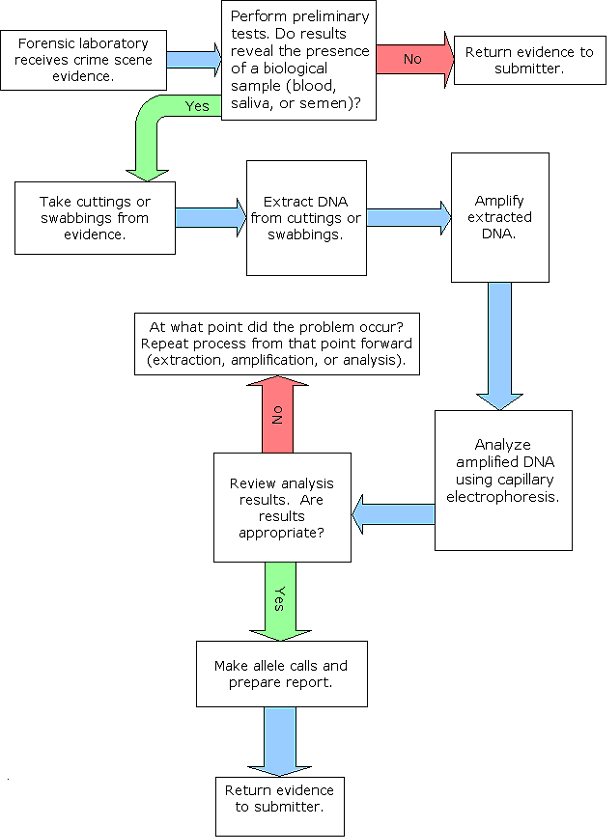Thus DNA is a code for making proteins. Efficiency is the percent of work put into a machine by the user input work that becomes work done by the machine output work.

Dna Profiling An Overview Sciencedirect Topics
Modern DNA analysis is based on the statistical calculation of the rarity of the produced profile within a population.

. Forensic genetics can provide information on the events which occurred at the crime scene or to supplement other methods of forensic. Polymerase chain reaction is a method of preparing DNA for forensic analysis ExplanationIn order to prepare DNA for the forensic analysis it must. The Gordon Research Seminar on Forensic Analysis of Human DNA is a unique forum for graduate students post-docs and other scientists with comparable levels of education and experience to share cutting-edge newunpublished scientific research.
Organic extraction methods are often preferred for the extraction of biological stains containing small amounts of DNA or degraded DNA01-05 These methods could be considered less harsh than other methods such as the use of Chelex beads because no. Using emerging technologies generally referred to as Next-Generation DNA Sequencing NGS an. Human mitochondrial DNA analysis in a forensic setting is currently limited in both breadth the amount of sequence data obtained and depth the ability to detect minor variants arising from mutations but present at very low levels.
Although the analysis of DNA is not generally considered as part of chemical analysis in the forensic sciences several DNA profiling methodologies use capillary electrophoresis to analyse the short tandem repeat or single nucleotide polymorphisms products from the. Polymerase chain reaction O B. The chapter discusses the sample preparation for inorganic analyses including chemical speciation.
Phenolic extraction and the removal of. The 2022 GRS will include discussion-based presentations that explore. The forensic use of DNA typing is an outgrowth of its medical diagnostic useanalysis of disease-causing genes based on comparison of a patients DNA with that of family members to study inheritance patterns of genes or with reference standards to detect mutations.
Difficult and highly degraded DNA samples are the bane of every forensic DNA analyst. DNA profiling is the determination of a DNA profile for legal and investigative purposes. PCR Method Enables Better Analysis of Degraded Challenging DNA Samples.
Biology 21062019 1500 liltonio. Deoxyribose Nucleic Acid DNA contains genetic information. When possible DNA samples are collected stored and transported from the crime scene to the laboratory carefully and with the proper protocols in place.
The capillary electrophoresis segment in the DNA forensics market is predicted to reach USD 11 billion by 2027. DNA profiling is based on the short tandem repeats STR and aids in human identification from biological samples. The polymerase chain reaction can be defined as the process which is used to amplify the DNA in the huge amounts.
DNA FORENSIC ANALYSIS 1. Sequencing however is not a skill that is part of the routine forensic analysis because of the relative rarity of requests and the need for. This chapter describes sample preparation in DNA analysis.
1 Get Other questions on the subject. Which is a method of preparing dna for forensic analysis. DNA analysis methods have changed numerous times over the years as technology improves and allows for more information to be determined with less starting material.
Structure of DNA and its physicalchemicals properties are discussed briefly. Nuclear transfer O C. Techniques using organic reagents for DNA extraction are well accepted in the forensic science community.
Unlike the RFLP procedure described previously the polymerase chain reaction PCR is a procedure that amplifies exceedingly small amounts of DNA and produces billions of copies of specific target regions within the human. The method that is required to prepare the DNA for the forensic analysis is to replicate in the amount that is easily detectable in any biomedical instrument for the analysis. A small amount of DNA is put into the instrument and it replicates to for a.
DNA codes the proteins that our bodies make which are necessary for survival. This Chapter examines different types of DNA tests and provides some rationale as to why a particular test is used in certain circumstances. DNA What it is.
Which is a method of preparing DNA for forensic analysis. Genetic analysis of mitochondrial DNA mtDNA has always been a useful tool for forensic geneticists mainly because of its ubiquitous presence in biological material even in the absence of nuclear DNA. In the last 30 years DNA molecular analysis has become an important tool in forensic investigations.
Polymerase chain reaction is a method of preparing DNA for forensic analysis. DNA also determines how much of. What is the method of preparing DNA for forensic analysis.
Capillary electrophoresis is a method of separation and detection of short tandem repeat STR alleles in DNA forensic laboratories. As submitted by the proposer. To understand the challenges involved in such technology transfer it is instructive to compare.
Which is a method of preparing dna for forensic analysis. This is easily accomplished in the lab once enough copies of the STRs are available which is done using polymerase chain reaction PCR. Making copies of a particular region of the DNA using PCR is one of the most reliable laboratory processes used.
Roughly speaking DNA Fingerprinting is a method of DNA analysis used by Forensic Scientists to help solve crimes. Gel electrophoresis O D. This technique was first discovered by Professor Alec Jeffreys of the University of Leicester in 1984 when he found that DNA varies in each human being and makes us unique.

Sources Of Dna For Forensic Analysis Download Scientific Diagram

0 Comments